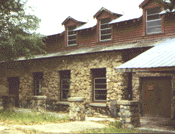 |
|
Camp Louis Farr
One of the largest trees in West Texas grows near the camp and an old stage coach line left history of Indian fights near the site. The camp that year cost $5.25 for one week and $10.00 for two weeks. The camp was fun similar to the previous camps except that older Eagle Scouts were helping out. Eagle Scout Ralph Logan directed the games at camp which consisted of water polo, baseball, volley ball, Ping-Pong, horseshoe pitching, and croquet. Eagle Scout Sam Scheuber was in charge of handicraft. Bill Erwin was the camp bugler and directed the camp daily newspaper, the "Nightly Howl." Eagle Scouts Luther Coulter and Harrison Clary stenciled the new belt honors and Edwin Buttery was director of photography and Stanley Sutton was in charge of night games, Indian and Pow-Wow nights, stunt night, story nights, whoopee nights and dramatics. The camp band was led by W. C. Crowley, director of the McCamey band. The camp started on a Sunday afternoon, May 24, with 150 Scouts with most of the boys having signed up for two weeks. Scouts in Texas came from San Angelo, Bronte, Sterling City, Brady, Melvin, Eden, Sonora, Junction, Ozona, Mertzon, McCamey, Texon, Iraan, Sheffield, Fort Stockton and Roswell, New Mexico. The camp band of 25 instruments, on May 30th, broadcast on KGKL from 7 to 7:30 p.m. by way of a telephone circuit into the San Angelo Telephone Company from camp. There was plenty of rain the first week but the Scouts succeeded in keeping dry and entertaining themselves with stunts in their tents. First week's activities included a miniature circus, minstrel show and various games and athletics. The second week, added by 100 boys from the first week and an additional 150 boys, featured a game of "capture the flag" which ran for 24 hours. Brice Draper was Camp Director with Frank Holiday of Junction serving as Assistant Camp Director. J. E. Fowler, Jr. was director of water activities and H. E. Draper, Jr. was camp doctor. Mabel and Eugene Martin served as camp chefs, with Mrs. B. W. Draper as camp dietitian. Waldo Williams was director of nature lore. Bill Wright and Charley Damron were directors of the older boy's program. Building of Yates HallDr. Hal P. Bybee, Head Geologist for the University of Texas, suggested that a suspended cable trolley be built from a mountain across the river at the camp to the camp grounds so that rock could be trucked to the construction site. A sturdy trolley was constructed with a bed of about four by eight feet suspended from used drilling cable strung across the river. It was thought that there was sufficient arc in the cable to slow the car as it reached the lower end of the cable filled with rock. A load was placed on the car and then released. The race was on. All that the slack in the cable accomplished was to allow the fully loaded car to pull the cable low enough to allow the car to cut the tops out of several trees on the way down. When the car reached the impact area, contact with the ground was severe enough to destroy the trolley, sturdy bed and all! Needless to say, the remainder of the rocks for the new dining hall were trucked down from the mountain by vehicle. A carload of cement was purchased, shipped to Mertzon, where it was unloaded by a group of Explorer Scouts and trucked to the site. A small gasoline powered concrete mixer was used to mix the cement. The foundation was poured by Explorer Scouts and WPA laborers. The entire crew was camped on the site during this construction. Ice Used To Split Rails - For Windows and DoorsCarr VillageThe
buildings had concrete
foundations, floors, copper screen sides and
windows, and a composition
shingle roof. All the buildings had 30 inch
high rock walls with
an imitation log siding built on the back ends of
each building. Buffalo Trail Council Rents Camp in 1941"Those who enjoy swimming may have instruction in life saving and swimming under direction of qualified instructors, MOrris said." "Further information may be secured from Scoutmasters Ernest Langley, Garland Vinson, J. P. Williams, Frank Coalson, Charles Kight, Harry Elliot and W. F. Ford, or J. C. Morris." The camp
ran for 26 years
with thousands of boys experiencing the adventure of
Camp Louis Farr.
When the council quit the camp in 1955, the
materials from Carr Village
were taken to Camp Sol Mayer where they were used to
build the old headquarters
and visitors building across from the dining
hall. All that remains
of Camp Louis Farr today is the two story Yates
dining hall, the caretakers
home and some rock walls in Carl Village..
Material for this story was taken from Panjandrum A History of Scouting in the Concho Valley Council 1911-2001, by Frank T. Hilton, 2001, and a newspaper story, publisher unknown, in August 1941. Updated March 4, 2009 Return to Other Camps of Concho Valley Council Return to Home Page |
 A
well was dug near the kitchen and an office and
craft storeroom were build
as well as dressing rooms for the swimmers.
The new campsite was
located several hundred yards from the site used on
Spring Creek the previous
year. It was out of danger of high water and
afforded an open playground
and large woods nearby.
A
well was dug near the kitchen and an office and
craft storeroom were build
as well as dressing rooms for the swimmers.
The new campsite was
located several hundred yards from the site used on
Spring Creek the previous
year. It was out of danger of high water and
afforded an open playground
and large woods nearby.